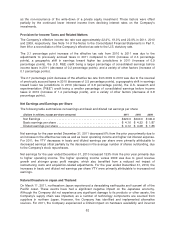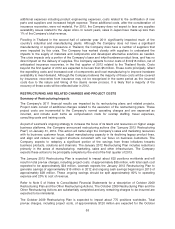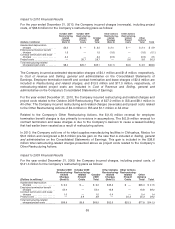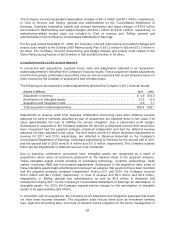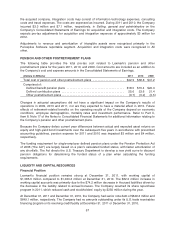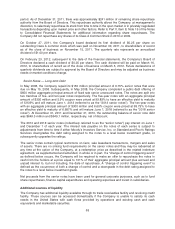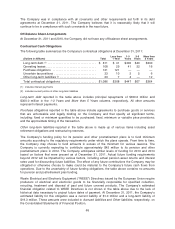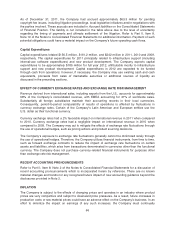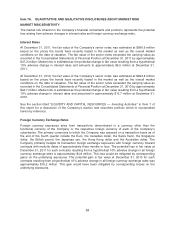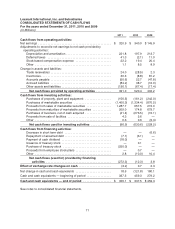Lexmark 2011 Annual Report Download - page 65
Download and view the complete annual report
Please find page 65 of the 2011 Lexmark annual report below. You can navigate through the pages in the report by either clicking on the pages listed below, or by using the keyword search tool below to find specific information within the annual report.The Company’s business acquisitions, marketable securities and capital expenditures are discussed
below.
Business acquisitions
In 2011, cash flow used to acquire businesses was lower than 2010 due to the relatively smaller
acquisition of Pallas Athena compared to Perceptive Software. Pallas Athena, which was acquired at a
purchase price of $41.4 million, is a BPM, DOM, and process mining software company that
complements the product range offered by Perceptive Software.
In 2010, the YTY increase in cash flows used to acquire businesses was driven by the acquisition of
Perceptive Software in the second quarter of 2010 for $280 million cash consideration, or $266.8
million net of cash acquired. Perceptive Software is an ECM software company and a provider of a
broad range of strong industry solutions. The acquisition enables Lexmark to immediately participate in
the adjacent, growing market segment of ECM software solutions. It also provides additional revenue
streams in software maintenance and professional services that are not paper usage dependent.
Refer to Part II, Item 8, Note 4 of the Notes to Consolidated Financial Statements for additional
information regarding business combinations.
Marketable securities
The Company decreased its marketable securities investments in 2011 by $96.4 million .The Company
increased its marketable securities investments in 2010 by $202.1 million. The Company decreased its
marketable securities investments in 2009 by $24.2 million. The Company decreased its investment in
marketable securities in 2011 in order to fund the share repurchases as well as the first dividend
payment in the fourth quarter.
The Company’s investments in marketable securities are classified and accounted for as
available-for-sale and reported at fair value. At December 31, 2011 and December 31, 2010, the
Company’s marketable securities portfolio consisted of asset-backed and mortgage-backed securities,
corporate debt securities, preferred and municipal debt securities, U.S. government and agency debt
securities, international government securities, certificates of deposit and commercial paper. The
Company’s auction rate securities, valued at $11.5 million and $18.0 at December 31, 2011 and
December 31, 2010, respectively, were reported in the noncurrent assets section of the Company’s
Consolidated Statements of Financial Position. During the second quarter of 2011, the Company
received $6.6 million related to two of the Company’s auction rate securities that were fully redeemed
at par by the issuers.
The marketable securities portfolio held by the Company contains market risk (including interest rate
risk) and credit risk. These risks are managed through the Company’s investment policy and
investment management contracts with professional asset managers which require sector
diversification, limitations on maturity and duration, minimum credit quality and other criteria. The
Company also maintains adequate issuer diversification through strict issuer limits except for securities
issued by the U.S. government or its agencies. The Company’s ability to access the portfolio to fund
operations could be limited by the liquidity in the market as well as possible tax implications of moving
proceeds across jurisdictions.
The Company assesses its marketable securities for other-than-temporary declines in value in
accordance with the model provided under the FASB’s amended guidance, which was adopted in the
second quarter of 2009. The Company has disclosed in the Critical Accounting Policies and Estimates
portion of Management’s Discussion and Analysis its policy regarding the factors it considers and
significant judgments made in applying the amended guidance. There were no major developments
61



